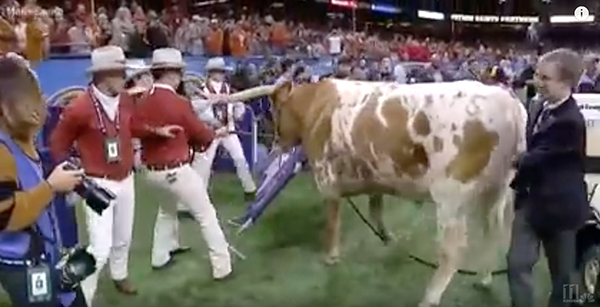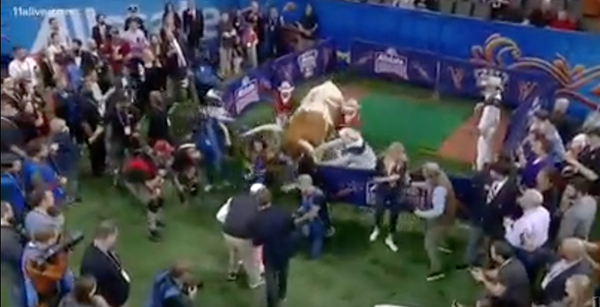PETA Calls For End to Live Animal Mascots Following Sugar Bowl “Incident”; Horse Lovers, What’s Your Opinion?
By: Brittany Bevis
Football fans across the country tuned in on New Year’s Day to watch the Allstate Sugar Bowl, which pitted the Georgia Bulldogs against the Texas Longhorns. The Longhorns would eventually win the game 28-21, but it was what happened just prior to kickoff that’s making headlines.
During the pre-game festivities, each team brought out their respective mascots, the Georgia Bulldog’s “Uga X,” a white bulldog, and the Texas Longhorn’s steer, “Bevo XV.” The two were supposed to meet for a pre-game photo opportunity; however, Bevo got a bit rambunctious with his handlers and broke through the barrier that separated him from the press.
A Little About Bevo
According to TexasSports.com, Bevo has been a fixture at games since 1916. There have been 15 Bevos since, all of which have taken their turn making appearances at home games and pep rallies. The organization in charge of caring for Bevo is The Silver Spurs, an honorary UT student service group that has held this honor since 1937. According to the website, Bevo XIV helped to provide more than $300,000 to the Neighborhood Longhorns Program through his public appearances and marketing partnerships.
Get to Know Uga
According to GeorgiaDogs.com, Uga X is from a line of pure white, English bulldogs that has been owned by Frank W. Seiler’s family since the first bulldog mascot in 1956. According to the Pittsburgh Press, UGA is the only major college that buries their mascots within the stadium. The previous nine bulldog mascots are buried in marble vaults by the south stands, and each stone is engraved with epitaphs like “How ‘Bout This Dog,” “Defender Of His Turf,” and “The Dog of the Decade.” Another fun fact is that Uga’s on-field home is an air conditioned doghouse that’s located near the cheerleaders’ platform on the field.
Back to the Incident
Thankfully, no humans nor animals were injured when Bevo tried to exit his pen. However, it’s certainly made for some interesting news in the days since.
PETA (People for the Ethical Treatment of Animals) is now renewing their call for the ban of live animal mascots with a post on their website entitled Bevo/Uga Video Shows Why We Need to Ban Live Mascots. The next day, they sent letters to both schools calling for the universities to stop using live-animal mascots.
In part, the statement reads as follows:
“It’s indefensible to subject animals to the stress of being packed up, carted from state to state, and paraded in front of a stadium full of screaming fans,” says PETA Senior Vice President Lisa Lange. “It’s no surprise that a skittish steer would react to a perceived threat by charging, and PETA is calling on the University of Texas and the University of Georgia to learn from this dangerous incident, retire their live-animal mascots, and stick to the talented costumed mascots who can lead cheers, react to the crowd, and pump up the team.”
UGA and Texas aren’t the only sports teams that currently have, or have used, live animal mascots in the past.
- North Carolina Tarheels – Rameses the Ram
- US Navy Academy- Bill The Goat
- Auburn University- War Eagle
- University of Colorado- Ralphie the Buffalo
- Louisiana State University- Mike the Tiger
- Baylor University- The Bears, Joy and Lady
- University of North Alabama- Leo III and Una the Lions
- University of Memphis- Tom the Tiger
Horse Mascots
The NFL Denver Broncos has “Thunder,” a white Arabian that leads the team out for games and gallops the length of the field when the team scores a touchdown. He has made appearances in four Super Bowls, at Times Square, and visits hospitals, schools, and parades. Three Arabians have held the position of Thunder since 1993, and they have all been owned by Sharon Magness-Blake. The original Thunder was a stallion and former show horse named JB Kobask who passed in 2009. Click here to read our Equine Chronicle story about Thunder’s trip to Super Bowl XLVIII back in 2014.
Florida State University has Osceola and Renegade, a horse and rider team that kicks off home games by riding to midfield to plant a burning spear in the turf. The tradition began in 1978 and, since that time, six horses have held the position. The horses are Appaloosas that have been provided by the Bill Durham family since 1978.
The University of Southern California has Traveler, a white horse that first made an appearance at a game in 1961. The position of Traveler has been held by Tennessee Walking Horses and Arabians, but it is said that the current mascot is a purebred Andalusian. Traveler’s duties include performing at home games, galloping around the field when the team scores a touchdown, and even making appearances in the Rose Parade.
So, fellow horse enthusiasts, what’s your opinion? Should live-animal mascots be a thing of the past, or is it ok for animals to be used as ambassadors for universities, sports teams, or clubs? Weigh in by emailing B.Bevis@EquineChronicle.com and you might see your comments included below this article.












